As the citrus season approaches, I’ve watched my orange tree blossom and develop into small round fruits with the promise of sweet juicy oranges to come. But as the season has progressed I’ve noticed my oranges are really small. If you have this problem too, like me, you’ll want to know why your oranges are so small and what you can do to fix it.
The most common reasons oranges are small is due to incorrect watering, a lack of soil nutrients including zinc, pest attack, and diseases.
Let’s find out more about each cause of small oranges along with solutions to fix the problem to grow a healthy harvest of oranges.
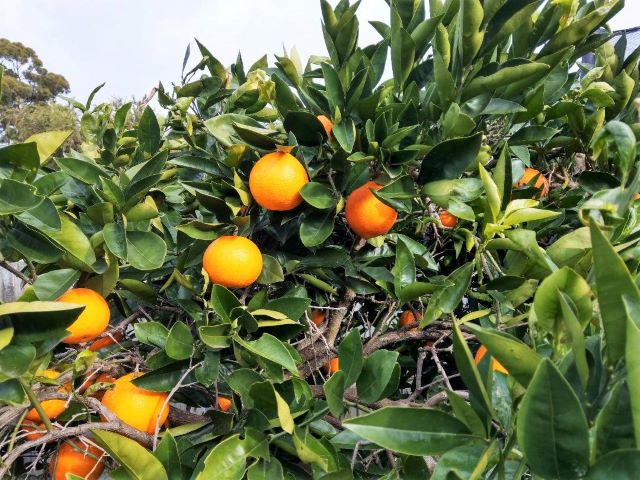
Related: Lemon Tree Dying? 7 Causes and Solutions!
Table of Contents
Incorrect Watering Causes Small Oranges
Although both too little and too much water can cause your orange tree to develop small oranges, it is more often the cause of over-watering.
Signs of over-watering can be pale leaves which will appear to be a yellowy-green color and can eventually drop off the tree. This happens as the soil is waterlogged and prevents the roots from taking the nutrients up the orange tree or, even worse, causing the roots to rot.
Orange trees favor being dried out between watering, so it’s ideal for monitoring the moisture in the soil between watering. You can do this by putting your finger into the soil up to your first knuckle- if it is dry, the tree is thirsty. If there is moisture in the soil, you can continue with your regular watering schedule.
It’s best to do these checks during the peak of spring and summer when the hot weather kicks in.
If your orange tree is stressed due to over-watering and the signs for this are apparent, then the first thing you should be doing is leaving it to dry out. Water-logging of soil can also be caused by a lack of organic matter or compost. So once the soil dries out, try to work some compost into the area.
Another option is to use a bamboo stake and make some holes through the soil- this will provide oxygen to the base of the tree and let it aerate. Just take care not to damage the roots.
A good watering routine for an orange tree to produce bigger fruits consists of watering two times per week while the tree establishes its new roots. After your orange tree establishes itself by displaying new leaf growth, you can give it a generous drink once every ten days. The recommended amount is 1 gallon (approximately 4 liters) of water per week.
Lack of Soil Nutrients Causes Small Oranges
Orange trees are hungry trees and insufficient soil nutrients will cause small oranges.
The first signs of soil deficiency will show up as orange tree leaves turning yellow while the veins remain green. The newest leaves will show signs first and in time will spread to the rest of the orange tree.
A lack of fertilization is a common problem. Orange trees require generous amounts of iron, zinc, and manganese each year for healthy growth a fruit production.
It’s ideal to fertilize your orange tree 3 times per year during the months of May, February, and October at around one pound (0.45kg) for each year of the tree’s age.
My preferred method of fertilizing my orange tree is by using composted manure.
If you don’t have access to composted manure, choosing an organic fertilizer will ensure you are giving your orange tree a well-balanced dose of the nutrients it needs.
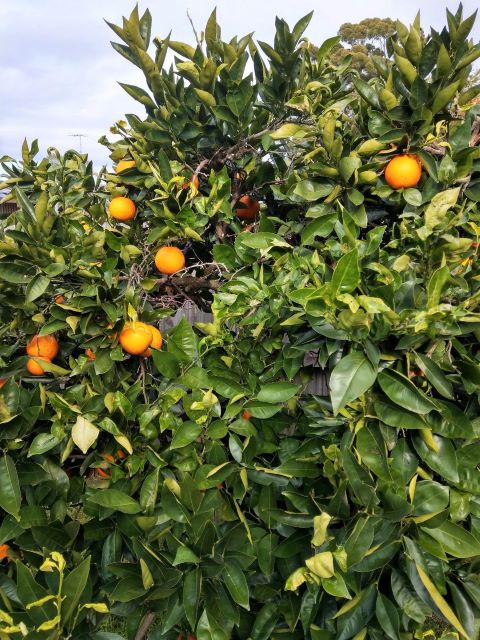
Zinc Deficiency
You can detect zinc deficiency in its early stages by green lines through the orange leaf veins and the leaves turning a yellowy-white color. A zinc deficiency that has progressed quite far will show the orange tree leaves being smaller than before and standing upright. If the orange tree is suffering from a lack of zinc during its fruiting stage, you will see the fruit is dehydrated, the skin will be smooth and light yellow and the orange fruit will be small.
Adding zinc can be quickly done by using an organic leaf spray with the ingredients of a kelp extract or a nutrient spray containing zinc.
You can find a suitable spray like this one to combat your orange trees’ zinc deficiency.
For optimum results, it’s best to spray the leaves of the orange tree during the spring months when the leaves are young. For good maintenance practice, you should spray your trees annually, and if your tree is suffering quite a bit, then an extra spray will be beneficial.
The citrus tree can handle a large amount of zinc, so don’t stress if you feel you have overdone it.
Using an organic citrus tree fertilizer at regular times throughout the year will also provide all the essential micronutrients, including zinc, your orange tree needs.
Pests That Cause Orange Trees To Produce Small Fruit
The main culprits for causing small orange fruits are the Citrus rust mite, Leafhoppers, and Stink Bugs.
Citrus Mites
You will likely notice a large infestation of Citrus mites if the leaves on your trees are stippled and lackluster.
Citrus mites are so small to see – we are talking about less than a quarter of a millimeter! They are usually brown, yellow, and red and are related to spiders and ticks.
Leafhoppers
The citrus leafhoppers are about 1/8-1/2 inches (3-13mm) green or brown-winged insects. They are hungry constantly and don’t mind destroying your produce.
You will see if they are present as they will scar your fruit and maybe even cause it to drop. The Leafhopper carries a severe disease that citrus trees can suffer, too – Spiroplasma Citri, also known as the Stubborn Disease of Citrus. This will cause your fruits to grow in a mutated shape and be undersized.
Stink Bugs
Stick bugs are a major pest of citrus trees. They can fly in from neighboring trees and feast on the stems of orange trees and fruit. If left untreated, stink bugs can cause the orange tree flowers and fruit to drop off the tree. In fewer severe cases, stink bugs will feed on the oranges, reducing their juiciness and stunting their growth.
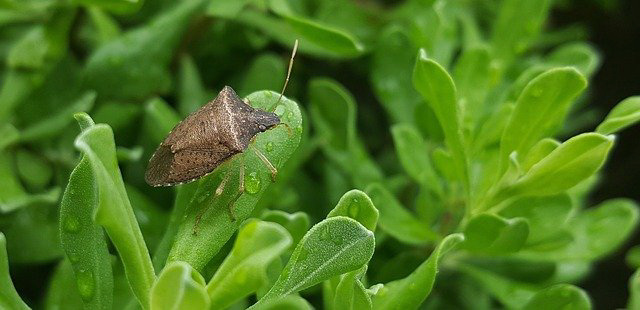
Pest Solutions
Before rushing out to buy one of the most lethal pesticides, you can find to kill these offenders, bear in mind that this is a fruit tree, and you aim to consume the fruits of your labor.
The most organic way to treat rust mites is by introducing more ladybugs to your garden; they are healthy insects and will eat the mites on your trees.
A widely used organic method to treat leafhoppers is horticultural neem oil.
And I have a great article for removing stink bugs here: Natural Remedies To Remove Stink Bugs From Citrus Trees.
Small Oranges Caused By Disease
Some diseases you might find that cause small oranges are Citrus Canker, Citrus greening, and the Stubborn Disease of Citrus (Spiroplasma Citri) that the Leafhopper carries. Let’s have a look at these diseases in a bit more detail.
Citrus Canker
Citrus Canker is a condition derived from bacteria that causes dead leaves and yellow and brown bruises on the fruit. An infection left for too long will cause the leaves to drop and premature orange fruit to fall.
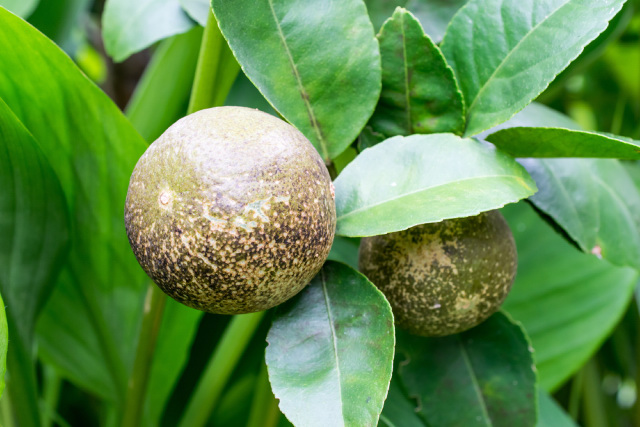
Citrus Greening
Citrus Greening shows up as yellowing patterns on the orange tree leaves, leaves are minimal and facing upward, and the orange fruit is small and sour. Citrus Greening is spread by a tiny insect called citrus psyllid (both the Asian and African psyllid).
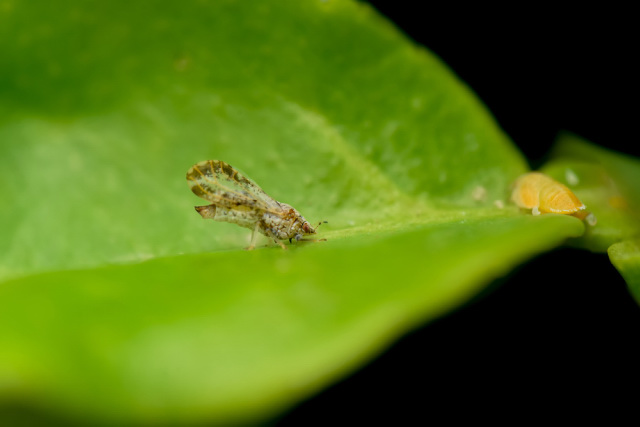
Stubborn Disease of Citrus
Stubborn Disease of Citrus (Spiroplasma Citri) presents as overall stunted growth of the orange tree, commonly caused by a viral infection, leaves will drop off the tree, and the fruit will grow in an abnormal shape.
Disease Solutions
A lot of effort has been put into finding a cure for these diseases, but still many trees that suffer severe infections have to be removed and destroyed.
You can use a copper bactericide to assist with Citrus Canker. Though it is most effective as a preventative treatment.
At the time of writing, there is no known cure for Citrus Greening and unfortunately, infected trees should be destroyed. On a positive note, researchers are working on a solution.
For the Stubborn Disease of Citrus, it’s best to replace young infected trees. Orange trees younger than 6 years should be destroyed while older trees should be assessed for damage.
The disease may be removed from parts of the orange tree and monitored for further damage.
Take preventative measures such as, controlling leafhoppers with the measures mentioned above and keeping the planting area free from weeds (which attract leafhoppers). Trap crops, such as sugar beets, can also be planted to keep leafhoppers away from your orange tree.
To minimize the risk of disease, practice healthy gardening techniques including pruning and removing the affected orange tree leaves during the spring season’s growth, management and removal of pests, and keeping your garden clear of debris.
Related Reading:
